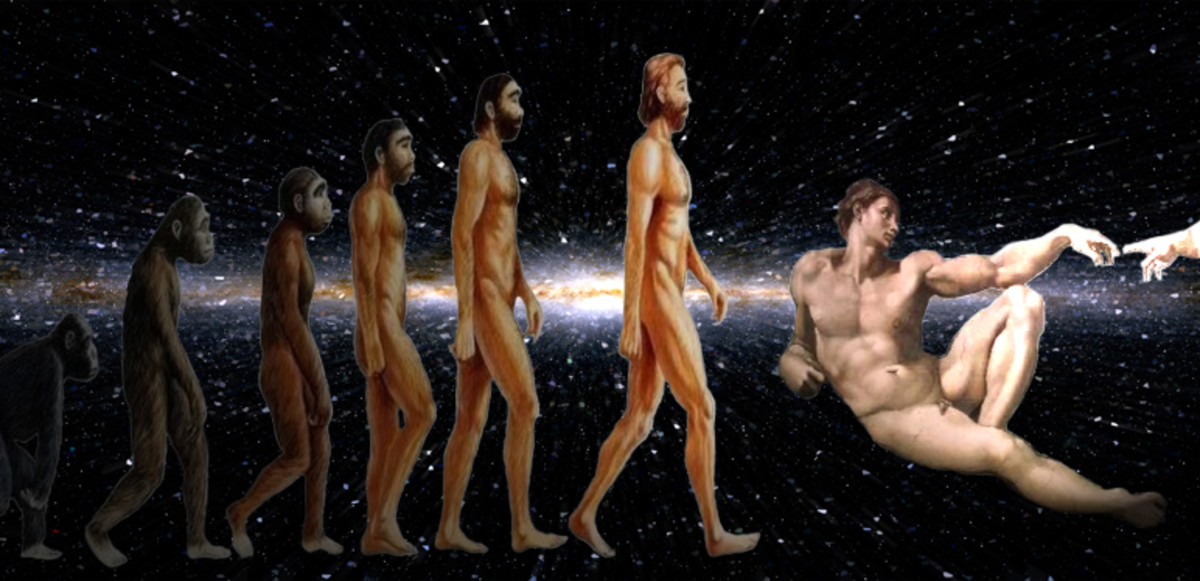Do you think humans in Gen1 and Adam in Gen2 are same event? Why?

The assumption that the creation of humans in Gen1 and the creation of Adam in Gen2 are two depictions of the same event is the one thing that makes Genesis seem so disconnected with our modern view of earth's history. If Adam was not the first human then not only does the rest of the bible make way more sense, but the events of early Genesis actually line up with known history. So what makes us so certain that both chapters are talking about the creation of Adam?Perhaps in Gen1, being made in God's image is pointing to an invisible energy. After all God is not a physical entity as such. In the verse although it states him, it further states male and female which could be pointing to the masculine and feminine energy that the Taoists believe as being our primordial origins. Like yin and yang further on downstream that is in and of each other. It is believed to be a singularity that consists of duality and non duality. Like one coin with two sides where the metal fills all dimensions and impressions.
Further on downstream, if you like, their are further extensions of this principle that can be seen in the manifest. Like heaven (universe) and earth, night and day, and right brain left brain just to name a few that came to mind.
In Gen2 the breath of life could very well have been the image of God that was breathed into the man made of dust.
The manifest and the mystery also come to mind.I do think there's something to the spiritual side as far as masculine and feminine goes. Like in Gen2:24 where it says a man shall 'cleave' to his wife and they will be 'one flesh'. Or Gen2:18 where God says "It is not good for man to be alone."
But as for the verse in Gen1 regarding humans being created in God's image/likeness, I think that's at least partially referring to physical form. The bible is consistent in its description of God as being a physical being with a physical form who sits on His throne in Heaven. Whenever God is described as being present, the passages always specify that it's His spirit. The one exception being when Moses asked to see Him. It described God as covering Moses with His hand and Moses seeing His back, but could not see His face.Yet in Gen2.5 there was no man to till the ground until the man of dust was made in Gen2.7. So man of dust and man in the image of God are likely referring to two different aspects of man.
But I don't think the line about there being 'no man to till the ground' means there were no men period. Gen2 is describing a specific geographic location. This is one of the places that I feel modern scientific knowledge adds clarity. There was a climatological event in the region specified in Gen2 known as the 8.2 kiloyear event. This was a climatological shift in that region that transformed what was once a lush, green landscape into an arid desert from 6200BC forward. Where before there was a human presence as humans in that age still migrated to find food, this climatological event cleared that landscape, making it match how Gen2 described it.
Later, in Gen6, it describes what happened when descendants of Adam intermingled with the human population who were 'growing in number' in the region, most likely referring to Cain's city (Gen4).
In fact, if you first consider the idea that there was a population of humans in existence when Adam was created, then these first few chapters become much less ambiguous and appear to be telling a very deliberate story. A story where the interactions between these humans and the descendants of Adam, the man made from the dust apart from natural humans, is a vital part of the story throughout the books of Moses and beyond.You could be right. Our lineage goes back to the nothingness and I don't remember Adam being mentioned but then there are many versions. Most of which are in ancient Maori or pictorial form that cannot be deciphered by modern Maori in it's entirety. What you say however makes sense.
Genesis 1 Talks about the origin and establishment of the Earth as a whole including all that's contained in it, present but without identity.
Genesis 2 Talks about the establishment of the man on the earth whose purpose gives each and everything it own particular identity. Since this is the purpose of man he is then also established as the ruler of the earth.I personally find it fascinating that God's first act after creating Adam was to bring the animals to Adam 'to see what he would call them'. These names that Adam came up with were the first creations not of God's making. In naming the animals, Adam was exercising what I think differentiated him from all of God's previous creations; an individual will. The ability to create things apart from God's will. The same capability that allowed him to disobey and eat the forbidden fruit.
Gen1, like you said, describes the establishment of all the Earth, including a population of humans. The same humans that God later 'regretted' putting on the Earth in Gen6 because Adam's free willed descendants began to find the 'daughters of humans' beautiful, took them for wives, and had children with them. This is described in the portion of Gen6 that's explaining why the flood was necessary. Adam's descendants (sons of God) intermingling with 'daughters of humans', mixing the capability of free will with the naturally evolved human bloodline, resulting in 'wickedness'.
Genesis 1 deals with the physical evolution of humans. From the sea, to creeping on the ground, to flying, to cattle, to humans"...male and female created he them, blessed them and told them to be fruitful....."
From these people (dust of the ground) was taken one human being who was given 'the breath of life' (the soul) and from this person was created their 'soulmate' as we would say.
There were two 'separate' creations, one physical and one spiritualIt's cool to see that others see something similar. The main thing that makes me think differently as far as Adam being taken from that same natural human lineage are the ages given for Adam and his descendants. Gen 6:3 specifies that humans are mortal and only live 120 years. We know through remains that humans have never lived longer than they do now. Yet Genesis says that Adam and his descendants lived for centuries.
The Sumerians, the inventors of civilization and the humans that populated the early Genesis landscape as far as region and time frame, also claim that there were beings who lived extremely long lives before a great flood, followed by lifespans gradually decreasing (Sumerian King's List). And all of the civilizations that originate in that region, Sumerians/Akkadians/Babylonians, Egyptians, Greeks, Romans, all tell very similar mythological tales of immortal beings in their ancient past who were human in form, male and female.
Initially, I thought the same as you. That Adam was actually an individual human chosen from naturally evolved humans and given a spiritual overhaul, so to speak. But between other bits throughout the books of Moses, as well as the mythological stories of that region, I've since begun to lean the other direction.
- John King IVposted 13 years ago
0
Great question!!! It boggled my mind for many years, since I noticed it. I addressed my views in my own article, but I love to put my opinion again. I believe that the original source of the creation story was one individual, who was called Moses in jewish tradition. For the ancients, Adam is both the name of one historical individual, but also refers to the idea of man, as in humanity, (a son of man, a human being). I think what Genesis is saying is that first God created "the adams" (mankind), on the sixth day. Much later after the seventh day, or during the era of the seventh day: God created Adam the individual. The whole thing is mostly an allegory, although jews did actually believe that a historical Adam really did exist. One, is a spirit being or idea that represents humanity. Example: Israel=Jacob (an individual and a nation). Adam =humanity plus a primitive individual). The symbol or spirit man, and then the real man of flesh and blood, made of carbon (or dust and clay). The jesus of Christianity is often compared or associated with Adam, as a son of God, and also a son of man. (A spirit person, or Messiah concept, yet also as a symbol of total humanity.)
It's hard to say considering the Hebrew word for 'humans' is where the name 'Adam' comes from. In the creation account the humans are described as 'the humans' [e-adm]. Then in Genesis 2 it's 'Adam' [adm]. This [adm] is given a story, a specific age, and a lineage, so he was definitely portrayed as an individual.
But outside of the name, which is a big reason in my mind that Gen1 and Gen2 have always been counted as the same event, the context between the two doesn't mesh. The biggest difference being that the humans in Gen1 were given specific commands that took them numerous generations to carry out (fill the earth/establish dominance in animal kingdom) followed by God deeming all He made good. Gen2 describes one individual in one specific geographic location who disobeys just one simple command.
The commands given to the Gen1 humans mirror exactly what homo sapiens did, and the actions of Adam and his descendants (murder, domesticating animals, stringed instruments, metal working, making bricks and building a tower and a city) mirror the advancements of technology and craftsmanship and the rise of civilization.
Many Jewish thinkers have rejected a literal reading of scripture for centuries. Theologian Moses Maimonides, a major influence for modern Conservative Jews, wrote in 1190, "The account of creation given in scripture is not, as is generally believed, intended to be literal in all its parts". The Vatican followed suit starting in the 1950's. If the Jews that authored these stories don’t take them literally, why would anyone else?
One major thing that literalists fail to see is when these stories were written, believing that the earth was flat and sea monsters were the norm.Keep in mind the Jews that shaped modern Judaism are not the authors. In fact, the books of Moses were ancient and ambiguous even in biblical times, with differing interpretations often being the dividing lines between factions.
The fact is nobody knows for certain how old the books of Moses are or who wrote them. We just know that parts were complete long before they were redacted together in the form as we know them now. The creation account was a separate piece, most likely a song or lyric of some kind, that was passed down orally for generations.
I think it's important to keep this perspective in mind. Especially considering the creation account very accurately lines up with the formation of the earth and the evolution of life as if it were witnessed from the surface of the planet.
Genesis 2, 3, 4, and 6 were also a complete narrative before being included into the complete book. Also unknown as far as age or origin. Yet the story told in those chapters describe events that correlate with the formation of the first civilization of Mesopotamia, down to the number of centuries between each event. Events that shaped humanity as we know it.
A lot of differing interpretations have been made of these books for as long as they've been around. But they're still fallible human interpretations, many of which were established centuries ago by people who knew way less than we know now. If you remove the fallible human element and just lay these ancient texts up against known history then there's a very real chance that there's much more to these texts that many give them credit for.
I think they were written by two different authors at different times representing their two different understandings of the creation events.
They are definitely two or more independent sources. One refers to God as Yahweh, the other as Elohim. The first 11 chapters are believed to be made up of a combination of the Jahwist source and the Priestly source, with the lists of descendants in Gen 5 and 10 edited in, if I remember right.
But even as independent sources, each one has relevant details that accurately describe actual history. I do believe you're right that they're two different creation stories, but I think they are talking about two different creations. In other words, I don't think the creation of humans and the creation of Adam were overlapping depictions.
The two biggest things are the correlations between the humans as described in Gen1 with actual homo sapien history, and the acknowledgement of others in the story of Adam through Noah. The first describes the world being populated by humans, the second tells a story in an already populated environment.
There were specific things the humans in Gen1 were told to do. The very same things commanded of them were qualities that emerged throughout each species of the homo genus. They were commanded to be fruitful and multiply, which obviously needed to happen. They were commanded to fill and subdue the earth. This is one thing humans did unlike any other species. Traveling long distances started way back in homo erectus. But homo sapiens literally populated the entire inhabitable world, including Australia and North America. And they were commanded to establish themselves as the dominant species in the animal kingdom. This is the other thing early humans did well, especially neanderthal and homo sapiens. Homo sapiens did it so well that they pushed both megafauna and neanderthal out of existence, establishing themselves as the only remaining species of the homo genus. Something else unique to humans. And they completed this just a mere few thousand years before the events of Gen2 forward.
I don't think Gen2 is a creation account in the way I think you mean because of the peripheral presence of 'others'. I think it's been long overlooked, but once it's seen it's kind of hard to miss. Gen4 and Gen6 are split by the genealogy added in Gen5. Gen4 describes Cain leaving for the land of Nod where 'others' he feared would harm him were. It then says he built a city. This followed by the bit about his 7 generations and Lamech killing a man and a boy. Gen6 begins with those really ambiguous first 4 verses that have baffled people for centuries. The only way those verses make any sense is if there's a population of humans who were different than Adam and his descendants. It actually specifies that humans are mortal and only live 120 years. Right there it says that there is a difference between humans and the 'sons of God'. In fact, it's the intermingling of these two bloodlines that's given as the reason for the 'wickedness' that warranted a flood.
Sorry this got so long, I could go on for days about this, and often lose at fighting the urge.
Two different events: The first is 'Dominion Man' male and female. The creation of Adam was a singular event. Adam was also created male and female, but confined to and keeper of 'The Garden'.
Related Discussions
- 38
Does god love punishment?
by pisean282311 13 years ago
was reading about noah's ark...something captured my attention...In the Genesis narrative, God observes that humanity is corrupt and decides to destroy all life.So god observed that humanity is corrupt...god forgot that humans are mere one of species of millions of species and to punish humans what...
- 22
If you could put the human condition down to one sentence, what would it be?
by Zara Rasul 9 years ago
If you could put the human condition down to one sentence, what would it be?
- 59
Why God Created Nations and Religions?
by Mahaveer Sanglikar 13 years ago
Why God created nations and religions and why he made them to fight with each other? Does God enjoys wars?
- 354
Who came first Adam and Eve or Homo Sapiens
by Castlepaloma 12 years ago
Man started wearing clothes 170000 years agoAdam and Eve were naked 6014 years agoAnatomically modern humans originated in Africa about 200000 years ago , most people can believe this, then how come most people are Religious?
- 84
If we all came from Adam and Eve, why are there different races?
by topgunjager 9 years ago
Why are there so many different races if we all came from adam and eve? Does it support evolution that we changed to different faces and colors and body types because we were exposed to different conditions that made our body adapt? If not then pls. explain.
- 28
What would have happened to man if Eve did not commit that sin in the Bible?
by Akita Daniel Omosivwe 12 years ago
What would have happened to man if Eve did not commit that sin in the Bible?One thing that I have been thinking about is Gen. 2:25 and Gen. 3:5, concerning Adam & Eve. These first people created were not ashamed of their nakedness until they committed that sin. In other words, it was after...













